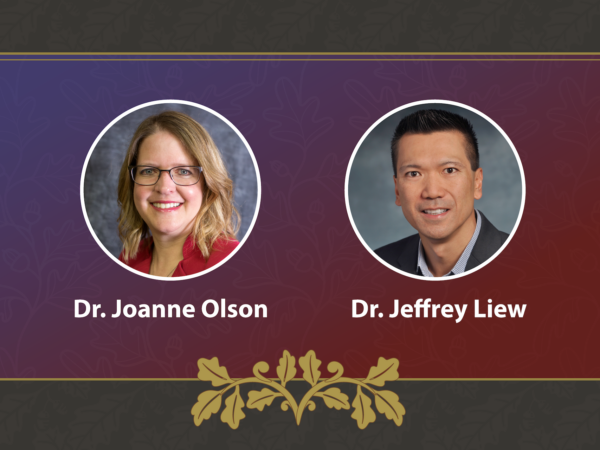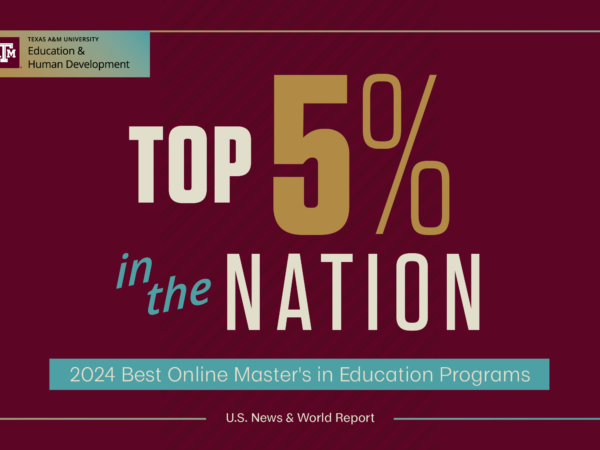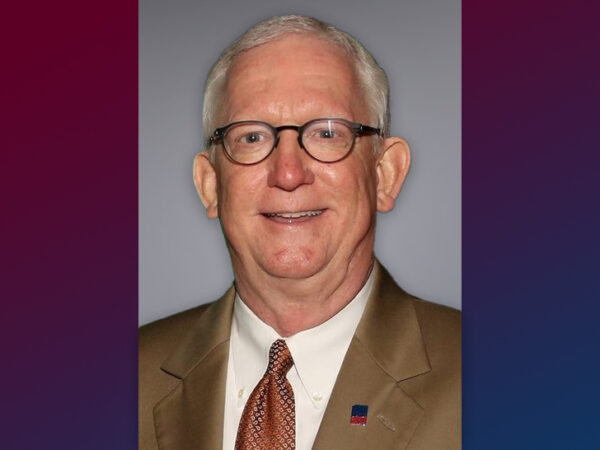Building the Educational Pipeline
Education reform advocates agree that a well-prepared corps of teachers is central to the development of a literate student population, and the most consistent predictor of student achievement in STEM is the presence of teachers with content knowledge in the subjects taught. Building the K-12 educational pipeline is critical to ensuring progress at every level.
TEACHING THE TEACHERS
Educating teachers, especially in high-need STEM fields, is well worth the investment when equipping students with a well-rounded education to be qualified contributors to society and competitive in the modern workforce.
“Developing strong math and science teachers plays an important role in getting young people interested in entering STEM fields,” says Dr. Robert Capraro, professor of mathematics education and director of the STEM Collaborative and Aggie STEM. “STEM teachers provide holistic insights into the teaching and learning processes for students, who will be more likely to major in a STEM field in college.”
The college is doing its part by producing more STEM teachers, certifying nearly 700 students to teach in STEM fields since 2008. Teachers and students of all ages can also take part in hands-on experiences in STEM fields through outreach programs, high-quality professional development, project-based learning and other training opportunities.
The goal of such programs as aggieTEACH is to train superior teachers. This nationally peer-reviewed model is a collaborative effort between the College of Education and Human Development and the College of Science. The program allows students to earn certification as secondary math and science educators and ensures they graduate in four years with deep content knowledge in their field.
Affiliated with aggieTEACH, the Texas A&M STEM Teacher Preparation Academy was recognized in 2013 by Quest for Quality for its ability to improve the state of STEM education by helping to prepare the next generation of science and mathematics teachers. Through the academy, teachers from Bryan and College Station ISDs participated in cutting-edge teaching methods and technology to make them more successful in the classroom.
RECRUITING THE LEADERS OF TOMORROW
Casey Ricketts, assistant director for recruitment and scholarships, spends a great deal of time traveling to high schools and community colleges meeting with students who want to become teachers. He looks for students who show potential for becoming passionate teachers and the desire to lead others to transform lives.
To better reflect the Texas demographics, Ricketts focuses on urban schools and those serving a high number of students from populations traditionally underrepresented, including first generation, low-income, African-American and Hispanic students.
One of the ways to introduce students to the rewards and opportunities available to them as educators is the ExpLORE (Exploring Leadership Opportunities and Rewards in Education) summer camp. Ricketts leads the camp, open to high school students in the top 25 percent of their class. The camp introduces students to teacher education programs, leadership opportunities, career opportunities and courses of study to enrich their knowledge of the teaching profession.
“Intense advising helps direct students to the right area of specialization, especially in STEM, bilingual or special education fields,” says Ricketts. The camp includes experiences like the Physics and Chemistry Roadshows to inspire students. They partner with aggieTEACH to demonstrate innovative techniques for teaching math and science.
AGGIE STEM AND STEM COLLABORATIVE
“We want to better prepare teachers for STEM so that students have a better idea of what STEM is all about,” says Dr. Mary Capraro, associate professor of mathematics education and AggieSTEM co-director. “By increasing the pipeline of more students liking science and math, we can move them to selecting a major in college connected with science, math or engineering and then a career in science, technology or engineering.”
Aggie STEM faculty research, create and provide professional development on the most effective teaching and learning strategies for math and science, emphasizing project-based learning that relies on student projects rather than textbooks.
Working with schools throughout the state, AggieSTEM strengthens math and science achievement. Several teachers in the program note that the project-based learning model makes a difference because students are able to retain what they learn and are able to apply the learning in a real-world, problem-based setting. “Teachers who followed the model closely have the most gains in closing the achievement gap,” Capraro adds.
STEM teachers provide holistic insights into the teaching and learning processes for students, who will be more likely to major in a STEM field in college.
AggieSTEM is also part of a network of centers across the state that serves 65 STEM academies and more than 1,200 school districts, including public, charter and private schools. These academies serve as demonstration schools and learning labs that develop innovative methods to improve science and math instruction.
“Developing highly qualified STEM teachers at the undergraduate and graduate levels is paramount to building a high-tech, highly valued workforce that will attract highly visible businesses to help make Texas the national leader in STEM jobs,” explains R. Capraro.
In 2013, the Texas Higher Education Coordinating Board awarded a two-year grant to establish the STEM Collaborative for Teacher Professional Learning. Partners in the project include Aggie STEM and The Education Research Center (ERC) in the College of Education and Human Development and the center for Mathematics and Science Education (CMSE) in the College of Science and Dwight Look College of Engineering.
In the current overall employment market, unemployed people outnumber job postings 3.6 to one. In the STEM occupations, job postings outnumbered unemployed people 1.9 to one. – Change the Equation
The collaborative provides innovative professional learning opportunities targeted at teaching strategies specific to STEM. Teachers participate in training on campus and via self-paced online modules, supported by instructors at A&M and based on college and career readiness standards.
“Our focus is to bring them all together to teach interdisciplinary project-based learning approach. When they go back to their schools, they will be able to teach in a way that prepares students for the workforce and for STEM careers,” says M. Capraro. “For any job, you will need more than just math, or science or engineering. It needs to be integrated and students need to see and understand that,” she adds.
With greater demand for students prepared to enter STEM related fields and careers, programs and initiatives – such as AggieSTEM, AggieTEACH and the Collaborative – serve to increase the pipeline and diversity of students entering STEM related fields.
For media inquiries, contact our Media Relations Coordinator, Ashley Green.
Fundraising
To learn more about how you can assist in fundraising, contact Amy Hurley, Director of Development ahurley@txamfoundation.com or 979-847-9455.












